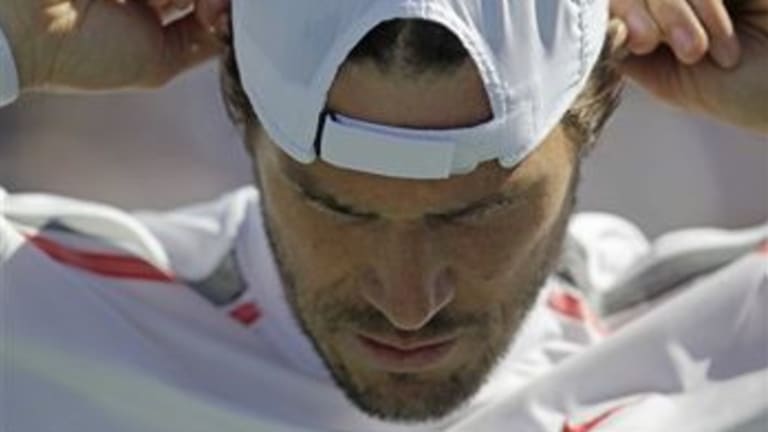INDIAN WELLS, CALIF.—A sure sign that the walls might be a little too thin at your hotel: You can hear someone in the next room snoring. That’s the sound I went to bed to last night; this morning I woke up to a husband and wife, one of whom was likely the snorer, and each of whom was likely well past retirement age . . . discussing Sunday’s Order of Play. Their emotions ran the gamut.
There was disappointment:
“Federer is playing the night session,” the husband informed his wife sadly.
“Oh, that’s too bad.”
There was surprise:
“You won’t believe it, but Andy Murray is out of the tournament.”
“Andy Murray lost. Really? Well, I’ll be darned.”
Finally, after he’d listed all of the matches on all of the stadium courts, to various degrees of approval and disapproval, he came to Court 7.
“Someone named Marcel Granollers is playing Tommy Haas.”
This got a reaction.
“Tommy Haas is still playing? Oh, we have to see him.”
Yes, Tommy Haas, 33, married with child, was playing. I can remember Haas saying, roughly eight years ago, that he was embarking on a “second career” following a serious injury. After numerous other injuries, surgeries, and mishaps over the years—remember when he turned his ankle on a loose ball during a first-round Wimbledon warm-up and had to withdraw?—I have no idea what career the German native and American citizen is on now. Much like Roger Federer, Haas says he wants to last long enough for his 2-year-old daughter Valentina to see him play. His most recent resurgence came with his trip to the Wimbledon semis in 2009, but more surgeries have kept him largely sidelined since.
After all of that, though, Haas didn’t look much different to me when I saw him out on Court 7 this afternoon than he did when I first saw him at the U.S. Open a dozen years ago. The traditional backwards hat, after various experiments without it, had returned to its rightful place. His errors were still followed by spiky outbursts of caustic German. And his one-handed backhand looked as cool as ever. Put it all together and it reminded me of that first glimpse of him at Flushing Meadows. That day three teenage girls waited patiently in the front row for three hours and four sets on a hot day, holding oversize tennis balls for the matinee idol of the moment to sign. When Haas finally won, though, he turned and walked in the other direction, toward the screaming hordes on the other side of the court. The girls were left staring blankly, with no Tommy signature to show for their loyalty.
Today's standing-room-only audience at Indian Wells, while none of them held giant tennis balls for their hero to sign, was still firmly behind the older and maybe wiser version of Haas today. They buoyed him into a third set against Granollers. His winners were met with the happy cry of, “That’s it, Tommy!” His errors elicited a sympathetic “Shake it off, Tommy!” A woman behind me even forgave Haas for a mistaken Hawk-Eye challenge, one that produced a stream of choice German. “Tommy didn’t see that,” she said understandingly, “but it really was out.”
They also refused to credit the younger, upstart Granollers with anything. One of his winning passes was greeted with a flatly bitter call from the top of the stands: “That was lucky.” (Granted, "Let's go, Marcel!" just doesn't have a very American ring to it.)
Tennis fans are suspicious of the new kid on the block, and Haas’s spiky outbursts weren’t always met with so much understanding. But tennis fans are loyal to 33-year-olds who have fought as long as Haas—they get to be part of the family. Most of the audience today was much older than Haas, and they wanted to see age make an improbable triumph over youth.
As the third set progressed, though, it was easy to see why age triumphs so rarely in tennis. On the surface Haas looked and played the same way he did when he was 21, but a closer inspection revealed a leaner body, a thinner face, and a little less pop on all of his strokes.
The years revealed themselves most obviously in Haas’s vaunted backhand. The stroke was the same, but the mind behind it was no longer as bold or decisive as it had been in his free-swinging youth. Haas hesitated on easy balls, and swung through them either too soon or too late. Where he once ripped that shot with ease, he pulled it wide on one point today, then came through it too late on another. After one backhand that ended up in the net, he stared at his entourage in the stands hopelessly. Haas had lost his best shot. His mind wouldn’t let him hit it. It knew, too well, everything that could go wrong.
At 2-3 in the third, down break point, Haas flubbed one more backhand, coming up late and spinning it lamely into the net. The crowd was quiet. The man next to me, who had been rooting hard for “Tommy!” all afternoon, was let down. “Really?” he asked. That’s how it was going to end?
It was. Granollers showed no mercy in serving it out. But it was Haas who drew the autograph seekers. There was no screaming horde, as there had been at Flushing Meadows way back when; just five little kids with magazines. Haas tossed them a towel, then another towel. Then he flipped his sweatband in their direction. It didn’t get any takers. Finally, as he walked off the court, he handed them something that he looked thoroughly sick of at that moment: his racquet.
